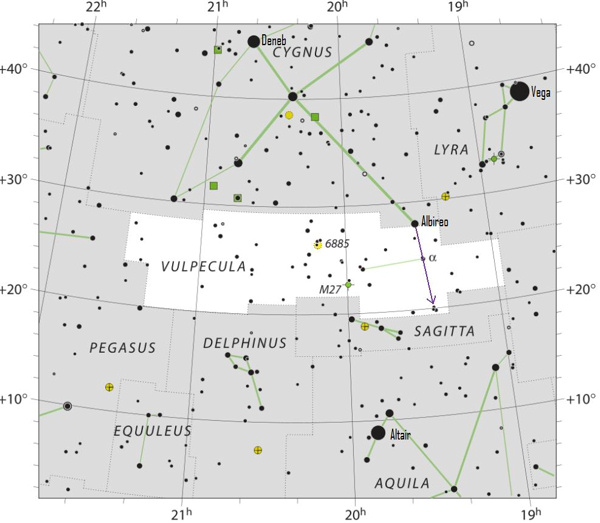
How to find it
The Coathanger or Brocchi’s cluster is a tiny asterism – pattern of stars that is not a constellation. This star formation looks exactly like its namesake, and is amazingly easy to make out through binoculars. The whole trick to viewing the Coathanger is to know just where to look.
As a prerequisite, first find the star Albireo at the base of the Northern Cross asterism. The Northern Cross is actually a clipped version of the constellation Cygnus the Swan, with Albireo depicting the Swan’s eye or beak. Either way, Albireo is your ticket to finding the Coathanger.
Perhaps the best way to locate Albireo is by way of the Summer Triangle asterism, made up of the three brilliant summer stars Vega, Deneb and Altair. Albireo is found in the section of sky roughly midway between Vega and Altair. Albireo, though only a modestly bright star, is easily the brightest star in that part of the heavens.

An imaginary line from the star Albireo and through the star alpha Vulpeculae takes you to the Coathanger in Vulpecula
Click here for a larger chart
With binoculars, look for the brightest star in the vicinity of Albireo. That star is called Alpha Vulpeculae, which appears as a double star through binoculars. These two stars are not physically related, however. They reside on the same line of sight by happenstance. Alpha Vulpeculae resides about 300 light-years away, whereas 8 Vulpeculae lies about 490 light-years distant.

Draw an imaginary line from Albireo through Alpha Vulpeculae to locate the Coathanger. In most binoculars, Alpha Vulpeculae and the Coathanger fit within the same binocular field of view, though just barely. Six stars form the bar of the Coathanger, while four stars make up the hook. From mid-northern latitudes, the Coathanger often appears upside-down, so some people call it the Ski Lift.
If you get lost using binoculars, place the sky object you wish to locate at the top of a tree or some such thing. Then follow the tree upward with binoculars until you catch sight of the object.
Notes on the sky chart
Our sky chart at the top of the page shows the stars as they appear in middle July, around midnight (1 a.m. daylight saving time). Because the stars return to the same place in the sky some 2 hours earlier with each passing month, this sky chart also shows star positions for about 10 p.m. (11 p.m. daylight saving time) in mid-August, 8 p.m. (9 p.m. daylight saving time) in mid-September and 6 p.m (7 p.m daylight saving time) in mid-October.
Since these stars shine from south to overhead at these times, you might want to sprawl out on a reclining lawn chair, with your feet pointing southward. The Coathanger or Brocchi’s cluster hangs high, so viewing the Coathanger from a reclining position saves on neck strain. Incidentally, Brocchi’s cluster isn’t a true cluster, but a chance alignment of physically unrelated stars.
The stars move from east to west during the night – just like the sun moves from east to west during the day. Nonetheless, the stars stay in the same position relative to one other, so you can always star-hop to the Coathanger via the stars Albireo and Alpha Vulpeculae.
The Coathanger’s position is at RA: 19h 26.47′; Dec: 20o 11.93′




















